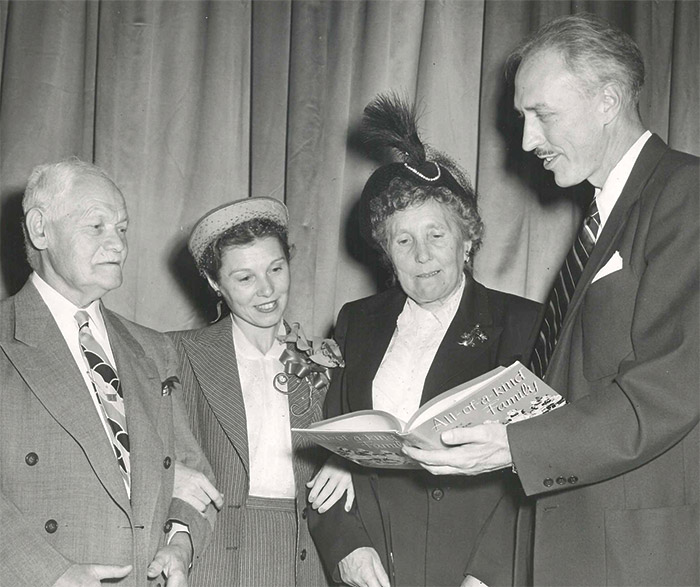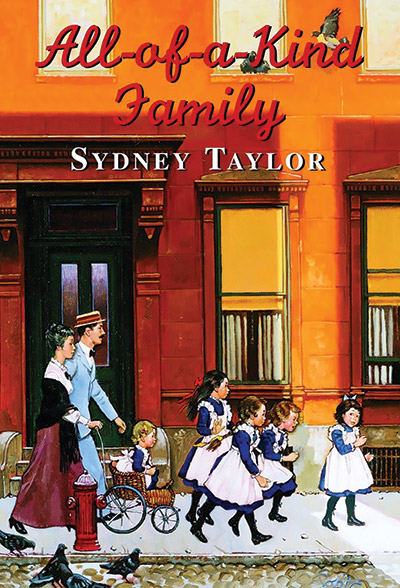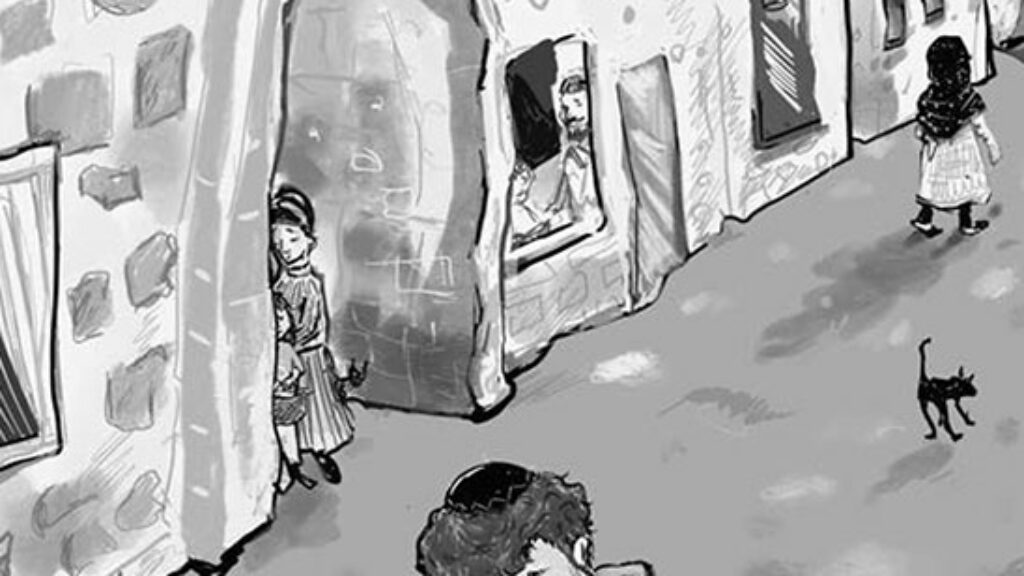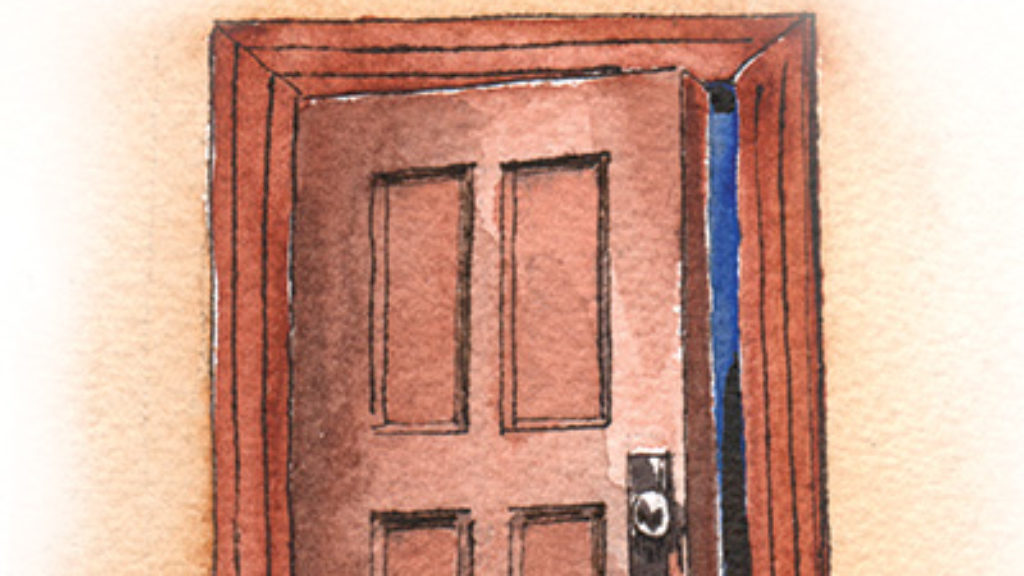All-of-a-Kind Americans
From the moment in 1951 when young readers were introduced to Ella, Henny, Sarah, Charlotte, and Gertie on the first pages of All-of-a-Kind Family as they hurried to visit the library one Friday afternoon, they were enchanted by the children’s bounce and good humor—and by the warmhearted approach of their author, Sydney Taylor. This was long before I learned to read, but later, I, too, would take great pleasure in them. Taylor’s stories about growing up during the early twentieth century as part of a big, busy family in New York’s Lower East Side featured children who didn’t seem so different from Jewish kids like me. The five sisters (and eventually one brother) in what would become a five-novel series were busy with school, reluctant to help around the house, and prone to accident, fib, and misadventure, but they were also immersed in a joyful, vibrant Jewish culture. They borrowed their sisters’ clothes without permission and squabbled—but they always made up.
And who wouldn’t want a mother like theirs? She was organized and unflappable, handling any but the most serious situations with hard work, a loving heart, and patience. When the kids don’t want to dust, she turns it into a game:
“It’s a game of hide-and-seek,” Mama answered. “I have hidden a dozen buttons in the front room. If the one who dusts can find those twelve buttons, she will have done a wonderful dusting job, and I won’t even have to check up on her. Now let’s see, whose turn is it to dust today?”
When Sydney Taylor wrote the semiautobiographical All-of-a-Kind Family, it was the first mass-market children’s book to focus on Jewish characters and their lives. Her older peer Sadie Rose Weilerstein had published books with Jewish presses for Jewish audiences, but Taylor’s books also found many eager non-Jewish readers despite their casual Jewish references—“You’ll have to make up with her when Yom Kippur [Day of Atonement] comes,” Ella reminds her sister—and stories of sitting around the Sabbath table.
Sydney Taylor was born Sarah Brenner in New York City on October 30, 1904. She was the third child of Cilly and Morris Brenner, Eastern European Jews who had met and married in Germany before immigrating to America. The everyday adventures of Sarah and her four sisters (hence, “all-of-a-kind”) were the subject of the All-of-a-Kind Family books, the first three of which were published in the 1950s.
The later, less lauded novels, All-of-a-Kind Family Downtown and Ella of All-of-a-Kind Family, were published in the 1970s. As June Cummins’s title, From Sarah to Sydney, suggests, the transformation of Sarah Brenner—a naive girl of traditional Jewish upbringing from the Lower East Side—into Sydney Taylor—a cosmopolitan artist whose name obscured both her sex and her ethnicity, even as the lives of Jewish immigrant girls became her main subject—is its central theme.
All-of-a-Kind Family began when Taylor wrote down the bedtime stories she told her daughter, Jo. Basing them on her childhood memories, Taylor planned these stories as Jewish ones from the outset—Jewish stories with Jewish characters for her Jewish daughter. Cummins writes:
It was impossible to find books about Jewish children at bookstores or public libraries before All-of-a-Kind Family. When she became known as “one Jewish writer who has managed to invade the Gentile book market for her principal source of income,” she excoriated Jewish publishing houses for failing to provide good, appealing literature for the avid readers Jewish children were known to be, offering them instead cheaply produced, unattractive, morally heavy-handed, and parochial publications. According to Taylor, Jewish educators were largely to blame because they were so mired in finer points of dogma that they lost sight of every child’s love of a good story.
But the stories were not only good in the sense of being entertaining. Taylor also had messages she wanted to deliver, in particular on the importance of first-wave feminism, cultural tolerance, educational reform, and progressive parenting—values she did not find reflected in contemporary Jewish children’s literature.

The Follett Publishing Company accepted Taylor’s very Jewish manuscript, with its all-American immigrant kids who relished their mother’s gefilte fish and spoke in Yiddish to the butcher, but they also had some suggestions. Taylor struggled to get her editor, Esther Meeks, to stop expecting Jewish customs to mimic Christian ones. To a woman used to the solemnity of church, for example, the raucous celebration of Purim or Simchat Torah seemed impossible. Meeks also urged Taylor to add more non-Jewish characters to her books. So Taylor created the kind, elegant “library lady,” from whom the children check out their books every Friday afternoon, and Charlie, the peddler who hangs out at Papa’s junk shop down by the East River but “was different from the others . . . handsome, blond, and blue-eyed, and a good deal younger than most of the peddlers.” Meeks also encouraged Taylor to work in elements that made the Americanness of her characters indisputable, including a chapter about Independence Day in the first volume of the series. Moreover, Meeks insisted that Taylor play down Judaism in her press appearances. This queasiness about being “too Jewish” is, of course, part of the story of midcentury American popular culture, but the success of the All-of-a-Kind Family books is also part of the story of the postwar acceptance of Jews into the American mainstream.
June Cummins came to Sydney Taylor’s life as a professor of children’s literature at San Diego State University (SDSU), but as the project developed, its scope expanded to every aspect of Taylor’s life and the ways in which it exemplified the possibilities open to an artistic Jewish woman in twentieth-century America. Cummins does an outstanding job of placing Taylor’s writing in the context of her other favored forms of storytelling: theater and dance. Well before she published a book, Taylor had performed on stage and studied under Lee Strasberg, along with her sisters Ella and Henny. Strasberg remarked that he “seemed always to be bumping into one Brenner or another,” and it was the founder of Method acting who first suggested that Taylor dance in Martha Graham’s famous avant-garde troupe, which Taylor did for several years.

While she is remembered for her All-of-a-Kind novels, Taylor spent most of her creative life as the director of drama and dance at Camp Cejwin in the Catskills, a program she ran every summer for thirty-five years. Cejwin was a project of the Central Jewish Institute and had been created “to integrate Judaism with the American way of life.”
This was precisely the process that the All-of-a-Kind novels documented—that Fourth of July chapter Taylor’s editor had asked for begins with Ella helping Mama make potato kugel—and Taylor gave the job all she had. Indeed, one of the surprises of Cummins’s biography is that Taylor herself was not very religiously observant as an adult. She expressed her Jewish identity largely through her work, in part because her husband, Ralph, was far less interested in Jewish life. Taylor herself approached her task as Jewish artist-educator in the somewhat Reconstructionist spirit of the Central Jewish Institute:
Taylor’s seriousness about the connection between the arts and religious experience colored her summers at Cejwin and how she approached her young charges. Because Hebrew schools and Sunday schools already spent so much time on holidays and holiday pageants, Taylor felt she had a tremendous opportunity and responsibility to expand the children’s understanding of the spirit and culture of Judaism.
She turned to Tanakh, both biblical stories right from the text and midrashim, and Jewish history for inspiration.
Every day of the summer, Taylor listened to the interests and enthusiasms of Cejwin campers. Working with these young performers gave her a handle on what they found entertaining. Taylor’s experience writing and directing children’s performances had an additional impact on her literary success: she knew how to talk to children and give a dramatic, charming book talk.
There’s a scene in All-of-a-Kind Family Uptown in which Mama has been rushed to the hospital for an appendectomy. In it, Ella muses, “Before, no matter what happened to any of us, there was always Mama to turn to. Mama’s so strong—like a mountain! No matter how hard we lean on her, we know she won’t topple.”

The most startling revelation in Cummins’s book is just how much the fictional Mama diverges from her model, Cilly Brenner. All-of-a-Kind Family’s Mama is affectionate and optimistic, even if she is a stickler for cleanliness and order; Cilly was often emotionally distant, sometimes demanding, and struggled with depression. Her large family did give her pride, but its size and requirements were also challenging, even overwhelming, for her. When she was pregnant with Irving, who is called Charlie in the books, she even attempted at one point to obtain a medical abortion, but the doctor never showed up at her house. Like some of the recent revelations about the less-than-idyllic life of the Ingalls family of the Little House on the Prairie series, this comes as a shock to someone who grew up on these stories, even if one never imagined that they told the whole truth about the Brenners’ family life.
Taylor sterilized and streamlined other details of her childhood as well. Was she lying or failing as an artist to confront the truth of her experience? Cummins doesn’t think so: “Even though Taylor omitted some of the enormous trials experienced by her parents, she was not dishonest, only intentionally selective, in her portrayal of this young family’s transition to becoming Americans.”
It is certainly true that part of the charm of Taylor’s books is the seemingly effortless way in which Taylor folded her cultural agenda into these light, entertaining stories of family life. Still, having read Cummins’s biography, one now sees the family drama and anxiety behind some of these stories. Take the issue of discipline. Mama, who Taylor’s sister Charlotte later described as having had “a rough German upbringing,” which led her to discipline her children “fiercely,” becomes an apostle of progressive, nonpunitive parenting in the stories. Meanwhile, Papa, who in reality seems to have been the gentler parent, is made to look foolish and old-fashioned when he gives one of the girls a potch.
June Cummins’s biography of Sydney Taylor contains fascinating details and tells an important American Jewish story, yet it must be admitted that it is not an easy read. Cummins evidently worked on it for more than a decade and seems to have become so engrossed in the details of her subject’s life that she sometimes forgot the needs and interests of the reader. But such criticism must be tempered because, as Cummins’s husband, Jonathan Lewis, tells us in his moving acknowledgments, Cummins did not live to see the book through to the finish. She spent the last several years of her life working on it while struggling with amyotrophic lateral sclerosis. He writes:
At the end of 2015 when June became too ill to return to work at SDSU, she devoted herself to working on the book full time. By the following summer, her disease had advanced to where she could no longer type, but she could give dictation with the use of an eye-tracking communication device. At that point June asked Alix Dunietz if she might help. . . . Alix became hooked and came to our house for a few hours most days to work with June, rapidly moving from typist to research assistant and then collaborator. As a result of Alix’s devotion, June was able to finish a draft of the book before her death in early 2018.
It is to the great credit of Dunietz and Yale University Press that they carried Cummins’s book through to press. However, it is impossible to know what the final shape of the book would have been had it been fully revised by Cummins herself.
Like many authors of Jewish children’s literature, I have long aspired to win the Association of Jewish Libraries Sydney Taylor Book Award. Created by Taylor’s husband, Ralph, shortly after her death in 1978, the award continues today under the sponsorship of her daughter. It is a fitting tribute that puts the All-of-a-Kind reader in mind of the gracious Lower East Side library lady and the five charming little girls racing home “on happy feet” with their Shabbos reading.
Suggested Reading

Radical Kindness and Heroic Dogs: A New Anthology of Yiddish Children’s Literature
Honey on the Page, like the best anthologies, is an eye-opening work of literary history, gleefully introducing a sea of lightly known authors through both their work and through meticulously crafted biographical sketches.

Talmuds and Dragons
Like the medieval literature to which it pays homage, The Inquisitor’s Tale weaves in supernatural events and divine interventions, mythic beasts and wild peoples, and even entrées into medieval theology, all liberally peppered with puns and potty humor.

Books vs. Children
"Apparently it is very troubling for children to see their parents working, at least doing the kind of work that does not make itself visibly obvious."

Revisiting Herman Wouk’s City Boy
Remembering Herman Wouk's "gentle mockery at the shopworn pretensions of bohemian poseurs and ethnic Jews passing as nonhyphenated Americans."
Comments
You must log in to comment Log In